Page 152 of 165
BMW Service
BMW Annual In-
spection
BMW Service
BMW Inspection
Carried out in accord-
ance with manufacturer's
instructions
Odometer reading
Brake fluid, new Without BMW Integ-
ral ABS
With BMW Integral
ABS
Wheel circuit
Control circuit
Date, stamp, signature
BMW Service
BMW Annual In-
spection
BMW Service
BMW Inspection
Carried out in accord-
ance with manufacturer's
instructions
Odometer reading
Brake fluid, new Without BMW Integ-
ral ABS
With BMW Integral
ABS
Wheel circuit
Control circuit
Date, stamp, signature
BMW Service
BMW Annual In-
spection
BMW Service
BMW Inspection
Carried out in accord-
ance with manufacturer's
instructions
Odometer reading
Brake fluid, new Without BMW Integ-
ral ABS
With BMW Integral
ABS
Wheel circuit
Control circuit
Date, stamp, signature
10150zService
Page 153 of 165
BMW Service
BMW Annual In-
spection
BMW Service
BMW Inspection
Carried out in accord-
ance with manufacturer's
instructions
Odometer reading
Brake fluid, new Without BMW Integ-
ral ABS
With BMW Integral
ABS
Wheel circuit
Control circuit
Date, stamp, signature
BMW Service
BMW Annual In-
spection
BMW Service
BMW Inspection
Carried out in accord-
ance with manufacturer's
instructions
Odometer reading
Brake fluid, new Without BMW Integ-
ral ABS
With BMW Integral
ABS
Wheel circuit
Control circuit
Date, stamp, signature
BMW Service
BMW Annual In-
spection
BMW Service
BMW Inspection
Carried out in accord-
ance with manufacturer's
instructions
Odometer reading
Brake fluid, new Without BMW Integ-
ral ABS
With BMW Integral
ABS
Wheel circuit
Control circuit
Date, stamp, signature
10151zService
Page 157 of 165
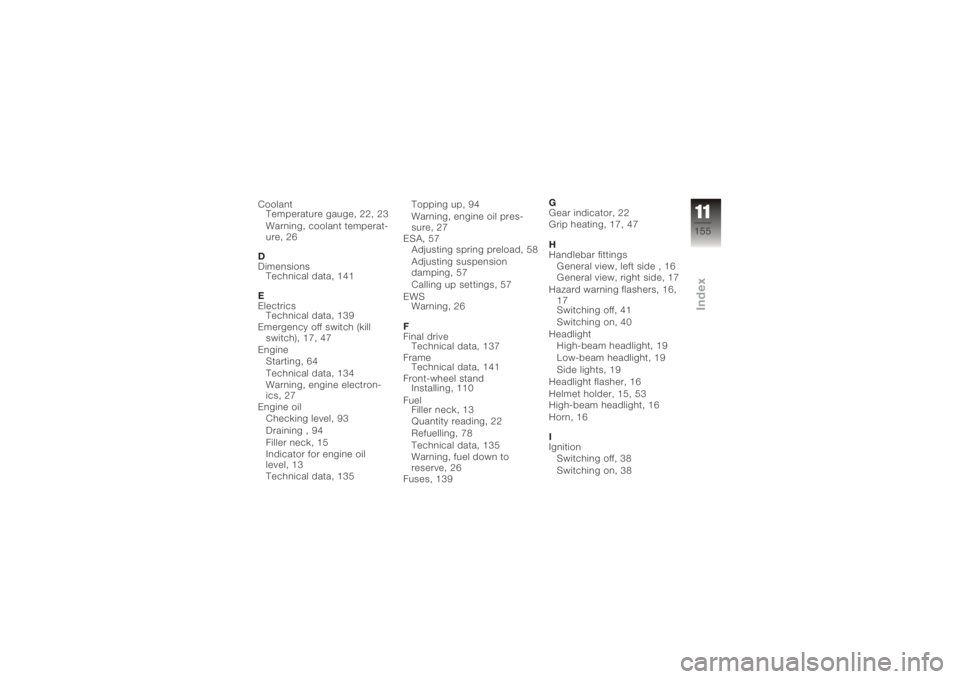
CoolantTemperature gauge, 22, 23
Warning, coolant temperat-
ure, 26
D
Dimensions Technical data, 141
E
Electrics Technical data, 139
Emergency off switch (kill switch), 17, 47
Engine Starting, 64
Technical data, 134
Warning, engine electron-
ics, 27
Engine oil Checking level, 93
Draining , 94
Filler neck, 15
Indicator for engine oil
level, 13
Technical data, 135 Topping up, 94
Warning, engine oil pres-
sure, 27
ESA, 57 Adjusting spring preload, 58
Adjusting suspension
damping, 57
Calling up settings, 57
EWS Warning, 26
F
Final drive Technical data, 137
Frame Technical data, 141
Front-wheel stand Installing, 110
Fuel Filler neck, 13
Quantity reading, 22
Refuelling, 78
Technical data, 135
Warning, fuel down to
reserve, 26
Fuses, 139 G
Gear indicator, 22
Grip heating, 17, 47
H
Handlebar fittings
General view, left side , 16
General view, right side, 17
Hazard warning flashers, 16, 17
Switching off, 41
Switching on, 40
Headlight High-beam headlight, 19
Low-beam headlight, 19
Side lights, 19
Headlight flasher, 16
Helmet holder, 15, 53
High-beam headlight, 16
Horn, 16
I
Ignition Switching off, 38
Switching on, 38
11155zIndex
Page 158 of 165
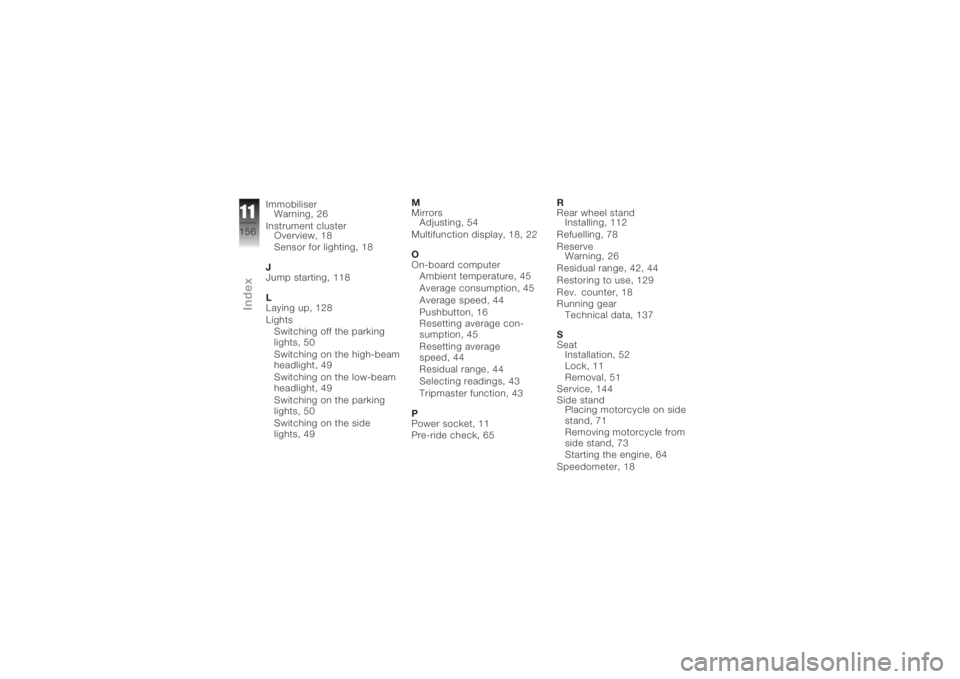
ImmobiliserWarning, 26
Instrument cluster Overview, 18
Sensor for lighting, 18
J
Jump starting, 118
L
Laying up, 128
Lights Switching off the parking
lights, 50
Switching on the high-beam
headlight, 49
Switching on the low-beam
headlight, 49
Switching on the parking
lights, 50
Switching on the side
lights, 49 M
Mirrors
Adjusting, 54
Multifunction display, 18, 22
O
On-board computer Ambient temperature, 45
Average consumption, 45
Average speed, 44
Pushbutton, 16
Resetting average con-
sumption, 45
Resetting average
speed, 44
Residual range, 44
Selecting readings, 43
Tripmaster function, 43
P
Power socket, 11
Pre-ride check, 65 R
Rear wheel stand
Installing, 112
Refuelling, 78
Reserve Warning, 26
Residual range, 42, 44
Restoring to use, 129
Rev. counter, 18
Running gear Technical data, 137
S
Seat Installation, 52
Lock, 11
Removal, 51
Service, 144
Side stand Placing motorcycle on side
stand, 71
Removing motorcycle from
side stand, 73
Starting the engine, 64
Speedometer, 18
11156zIndex
Page 159 of 165
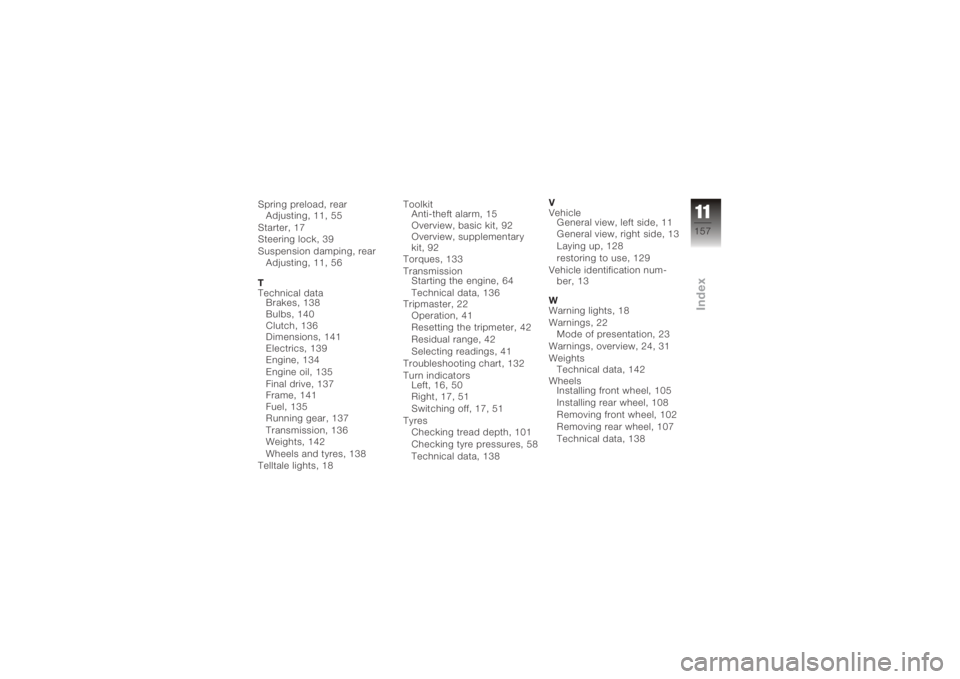
Spring preload, rearAdjusting, 11, 55
Starter, 17
Steering lock, 39
Suspension damping, rear Adjusting, 11, 56
T
Technical data Brakes, 138
Bulbs, 140
Clutch, 136
Dimensions, 141
Electrics, 139
Engine, 134
Engine oil, 135
Final drive, 137
Frame, 141
Fuel, 135
Running gear, 137
Transmission, 136
Weights, 142
Wheels and tyres, 138
Telltale lights, 18 Toolkit
Anti-theft alarm, 15
Overview, basic kit, 92
Overview, supplementary
kit, 92
Torques, 133
Transmission Starting the engine, 64
Technical data, 136
Tripmaster, 22 Operation, 41
Resetting the tripmeter, 42
Residual range, 42
Selecting readings, 41
Troubleshooting chart, 132
Turn indicators Left, 16, 50
Right, 17, 51
Switching off, 17, 51
Tyres Checking tread depth, 101
Checking tyre pressures, 58
Technical data, 138 V
Vehicle
General view, left side, 11
General view, right side, 13
Laying up, 128
restoring to use, 129
Vehicle identification num- ber, 13
W
Warning lights, 18
Warnings, 22 Mode of presentation, 23
Warnings, overview, 24, 31
Weights Technical data, 142
Wheels Installing front wheel, 105
Installing rear wheel, 108
Removing front wheel, 102
Removing rear wheel, 107
Technical data, 138
11157zIndex
Page 161 of 165
The most important data for a filling-station stop can be found in the following chart:Fuel
Recommended fuel gradeSuper Plus, unleaded
98 ROZ
Minimum octane number 95 ROZ
Fuel tank capacity 19 l, Usable
4 l, Including reserve of
Tyre pressures
Front wheel, tyre pressure 2.5 bar, When cold
Rear wheel, tyre pressure 2.9 bar, When cold
BMW recommends
BMW Motorrad
Order No.
01 41 7 698 831
08.2005
2. Issue The Ultimate Riding
Machine
Page 162 of 165
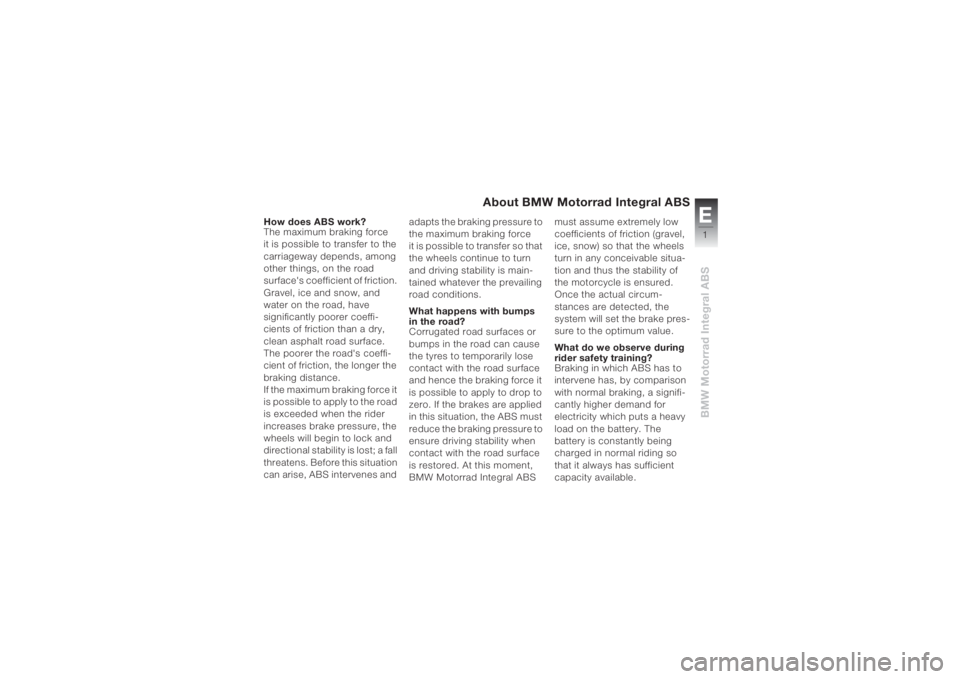
E1BMW Motorrad Integral ABS
About BMW Motorrad Integral ABS
How does ABS work?
The maximum braking force
it is possible to transfer to the
carriageway depends, among
other things, on the road
surface's coefficient of friction.
Gravel, ice and snow, and
water on the road, have
significantly poorer coeffi-
cients of friction than a dry,
clean asphalt road surface.
The poorer the road's coeffi-
cient of friction, the longer the
braking distance.
If the maximum braking force it
is possible to apply to the road
is exceeded when the rider
increases brake pressure, the
wheels will begin to lock and
directional stability is lost; a fall
threatens. Before this situation
can arise, ABS intervenes and adapts the braking pressure to
the maximum braking force
it is possible to transfer so that
the wheels continue to turn
and driving stability is main-
tained whatever the prevailing
road conditions.
What happens with bumps
in the road?
Corrugated road surfaces or
bumps in the road can cause
the tyres to temporarily lose
contact with the road surface
and hence the braking force it
is possible to apply to drop to
zero. If the brakes are applied
in this situation, the ABS must
reduce the braking pressure to
ensure driving stability when
contact with the road surface
is restored. At this moment,
BMW Motorrad Integral ABS must assume extremely low
coefficients of friction (gravel,
ice, snow) so that the wheels
turn in any conceivable situa-
tion and thus the stability of
the motorcycle is ensured.
Once the actual circum-
stances are detected, the
system will set the brake pres-
sure to the optimum value.
What do we observe during
rider safety training?
Braking in which ABS has to
intervene has, by comparison
with normal braking, a signifi-
cantly higher demand for
electricity which puts a heavy
load on the battery. The
battery is constantly being
charged in normal riding so
that it always has sufficient
capacity available. Info_I_ABS_en_xx.fm Seite 1 Dienstag, 19. Juli 2005 2:48 14
Page 163 of 165
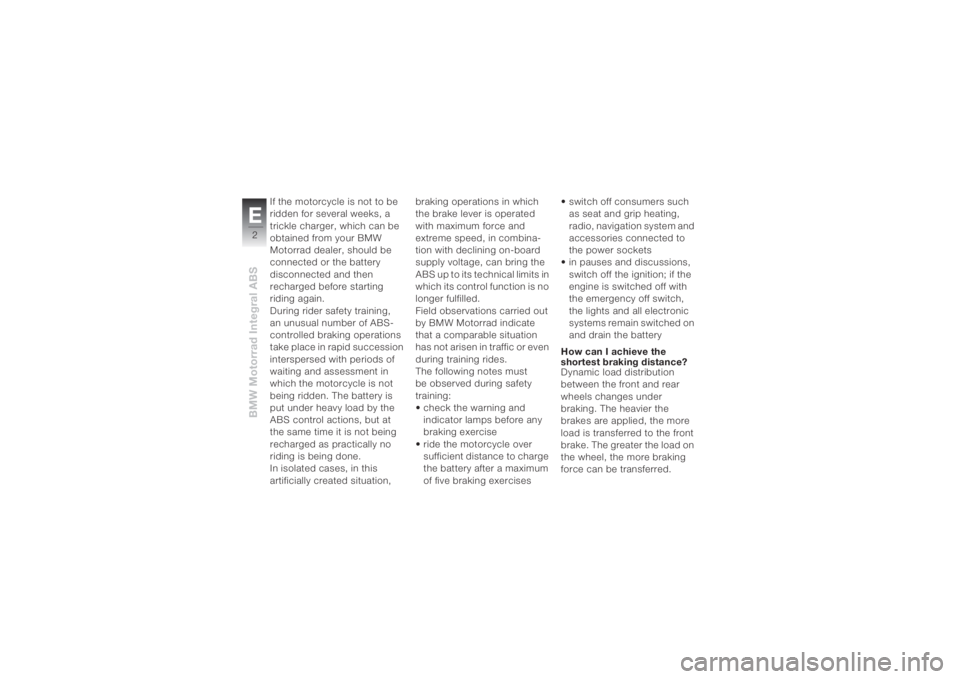
BMW Motorrad Integral ABSE2
If the motorcycle is not to be
ridden for several weeks, a
trickle charger, which can be
obtained from your BMW
Motorrad dealer, should be
connected or the battery
disconnected and then
recharged before starting
riding again.
During rider safety training,
an unusual number of ABS-
controlled braking operations
take place in rapid succession
interspersed with periods of
waiting and assessment in
which the motorcycle is not
being ridden. The battery is
put under heavy load by the
ABS control actions, but at
the same time it is not being
recharged as practically no
riding is being done.
In isolated cases, in this
artificially created situation, braking operations in which
the brake lever is operated
with maximum force and
extreme speed, in combina-
tion with declining on-board
supply voltage, can bring the
ABS up to its technical limits in
which its control function is no
longer fulfilled.
Field observations carried out
by BMW Motorrad indicate
that a comparable situation
has not arisen in traffic or even
during training rides.
The following notes must
be observed during safety
training:
• check the warning and
indicator lamps before any
braking exercise
• ride the motorcycle over
sufficient distance to charge
the battery after a maximum
of five braking exercises• switch off consumers such
as seat and grip heating,
radio, navigation system and
accessories connected to
the power sockets
• in pauses and discussions,
switch off the ignition; if the
engine is switched off with
the emergency off switch,
the lights and all electronic
systems remain switched on
and drain the battery
How can I achieve the
shortest braking distance?
Dynamic load distribution
between the front and rear
wheels changes under
braking. The heavier the
brakes are applied, the more
load is transferred to the front
brake. The greater the load on
the wheel, the more braking
force can be transferred.Info_I_ABS_en_xx.fm Seite 2 Dienstag, 19. Juli 2005 2:48 14